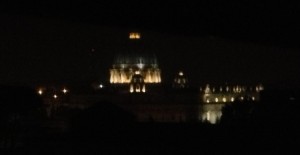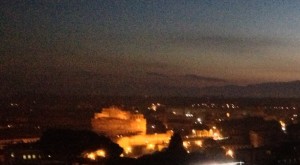Wednesday, October 10, 2012:
It is 5:30 a.m. here in Rome, and I am about to start my holy hour before morning Mass. In the picture, you see the lighted dome of St. Peter’s Basilica as it appears in the pre-dawn morning, glimmering in the darkness.
Lumen Gentium is the title given to Vatican II’s Dogmatic Constitution on the Church. The story is told that Blessed John XXIII pointed to a globe of the earth and announced “lumen gentium,” meaning that Christ Jesus is the “light to the nations.” The Church, of course, has as her primary mission to proclaim Christ to the nations, and that shimmering dome of St. Peter’s, all lighted in the darkness, speaks to that great mission. The Church serves Christ Jesus and indeed is the mystici corporis, the Mystical Body of Christ, of which the Lord Jesus is the head and we are members.
Recently, I saw among choices for the cover of Christmas cards the dark scene of the magi camped a distance from Bethlehem, where the star was lighting the manger scene. The subtitle was something like “Searchers for the Truth.”
Yesterday, I read about a study conducted by the Pew Forum on Religion and Public Life that reported a rise in the percentage (from 15% to 20%) of the “nones.” Nones are those who claim no religious faith; I believe that the response checked most frequently was “no particular religion.” It has been observed that our culture makes it a bit easier to take this position publicly, but I suspect there are searchers for the truth among this group. In fact, last October, Pope Benedict invited some representatives of this group to Assisi when world religion leaders gathered in dialogue. Yesterday at the Synod, I heard again about the “Courtyard of the Gentiles” being promoted as a means of outreach to searchers with no religious affiliation.
I have been thinking about two ways to contribute to this outreach. The first was suggested to me when I met in focus groups with about 40 young adults a few Sundays ago at Holy Spirit Church in Louisville. A number of these 20-something adults reminded me not to fear inviting them to Christ and to the fullness of Church teaching. One said it clearly: “We are listening and want to hear.” My prayer is that those of us attending this blessed synod will be reminded of this desire to hear and to be both bold and loving in our recommendations to our Holy Father for the new evangelization.
The other way is a follow up of my intervention yesterday at the synod, the summary of which appears in the Vatican daily bulletins. I called for a generous use of the “Blessing of the Child in the Womb,” so recently approved for use in the United States and which I pray will be extended soon to the universal Church. Expressing how this blessing allows the Church to “warmly extend the love of Christ to families as they prepare for the birth of their child,” I hailed this sacred gesture as a way to announce to society the great gift of human life, as well as a gracious invitation for parents to begin preparing for the baptism of their child, once born.
While the text of my intervention is now the property of the synod and so will be used as those in charge would direct, I can share one thought that I frequently spoke about in Louisville and that emerged from another study from the Center for Applied Research in the Apostolate (CARA). This study revealed that nearly 80% of Catholics spoke of being proud to be Catholic. While, sadly, the presence at Sunday Eucharist falls well short of this percentage, this expression of pride reveals a strength and openness upon which to build.
Another local study, done of parents of Catholic school students in Louisville, revealed a resounding wish among parents to “do what is best for their child” – a sentiment that is deeply felt by so many at the time of the birth of their child. Thus, when I presented this “Blessing of the Child in the Womb” to the lay faithful, it was received very well, and most were very positive about the opportunity to invite expectant families to take part. Indeed, preparing for the birth of a child is a time for hope and excitement as well as natural concerns and anxieties, a time that provides a rich opportunity for support and prayers.
I pray that our work in the Synod will concentrate on reaching out and not simply waiting for these silent searchers to come to Christ, the “light for the nations.”
Today, we meet for the first time in small groups divided according to language. I look forward to a full day. Tomorrow our Holy Father will initiate the “Year of Faith” at a special Mass that also celebrates the 50th anniversary of the opening of the Second Vatican Council and the 20th anniversary of the publication of the Catechism of the Catholic Church. I was pleased to learn that the synod delegates are invited to concelebrate this outdoor Mass in St. Peter’s Square, and of course, I will carry your prayer intentions to the Mass.




